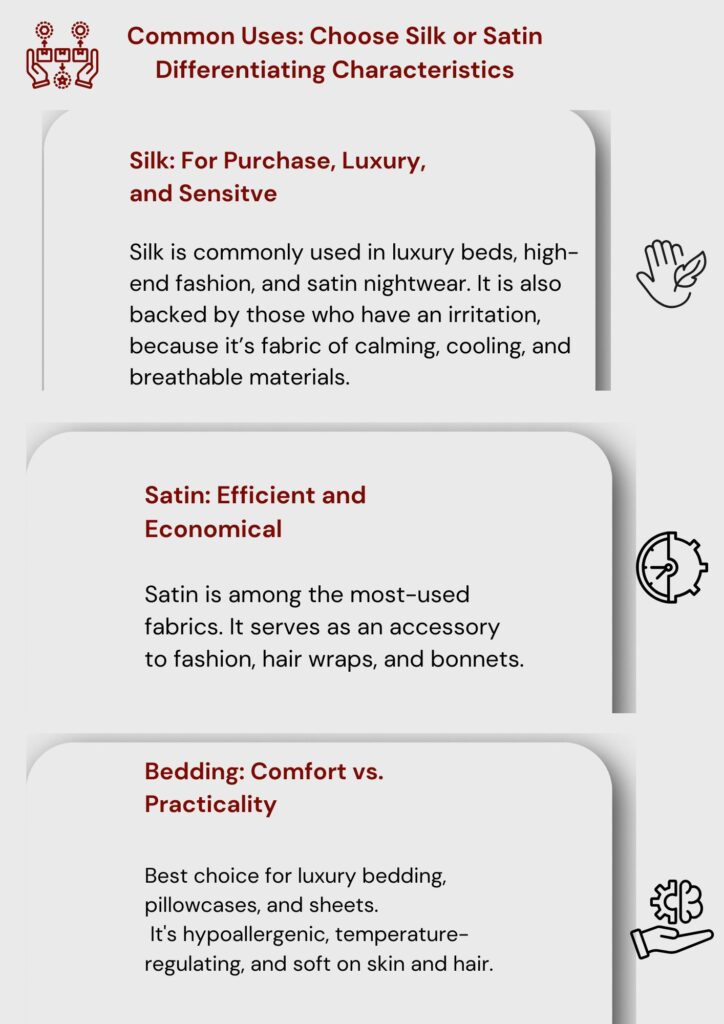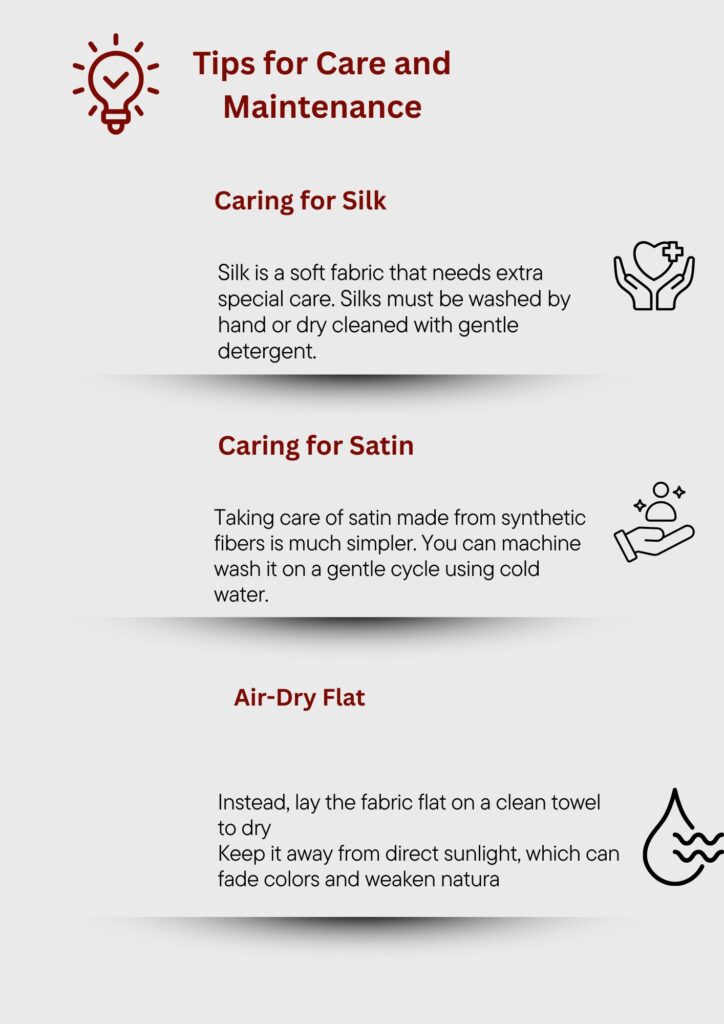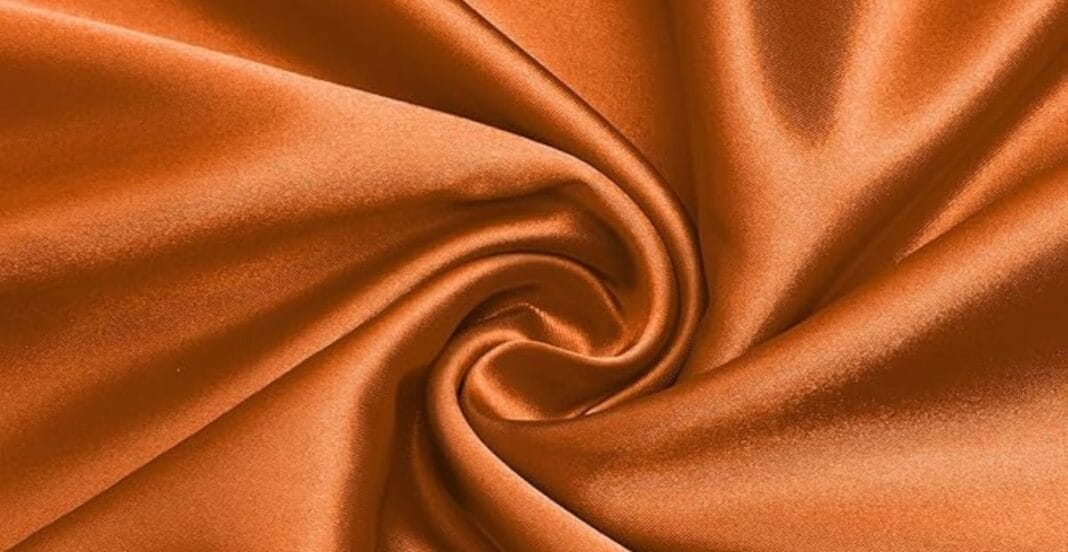Introduction
Silk is a natural protein fiber that silkworms produce. With a soft texture and luxurious feel alongside its natural sheen, silk has been treasured for centuries. Today, it is still used in high-end clothing, bedding, and various accessories.satin silk vs silk
Satin, on the other hand, has no fiber content and is instead a weave pattern. Silk fabric woven using the satin technique is called satin silk. Although the smooth, glossy surface of satin is appealing, it can also be made from polyester, nylon, and other synthetic fibers and not only silk.
It is a common misconception that satin silk is some sort of special silk. It’s actually quite the opposite. What’s unique about satin is how it’s woven, not the fiber. Thus, when people talk about “satin silk,” they are referring to silk fabrics woven using the satin style and not a new kind of silk, satin silk vs silk
Key Differences Between Satin and Silk
Material vs Weave
Silk comes from the cocoons of silkworms and is considered a natural material. It is also purer and more environmentally friendly compared to other textiles like satin. The latter is a weaving technique used to create a glossy surface along with a dull back. Unlike satin, this silk is woven, and thus classified as a textile. Moreover, satin as a weave can be applied to silk itself, as well as polyester, nylon, or even other fabrics.
Why this matters is important. A satin fabric may have no silk in it at all–it can be 100% polyester.
Composition
Pure silk s made entirely of silk protein fibers, which can often be called mulberry silk or charmeuse silk. For satin, it’s more diversified as it can be made from 100% silk but most times, it is made from polyester blends to cut costs.
Thus, while satin can contain silk, it doesn’t mean that it is unblended or natural. Always look at the label before paying.
Texture and Feel
Silk feels soft with a smooth surface and glimmering lightly. Cool to the touch and has a beautiful drape. More glossy and slippery, satin reflects light more than silk and thus, appears shiny especially under artificial lighting.
Silk has an organic and breathable touch, making it ideal for sensitive skin. Both fabrics feel luxurious.
Breathability
Breathability is the most beneficial feature of silk. Because it is made out of natural fibers, air can flow through easily, keeping you cool in summer and warm in the winter. This would not be the case for satin, especially if it is made from polyester, as it can trap heat and therefore, moisture which makes the fabric unsuitable for hot climates.
People who tend to overheat or have sensitive skin will find silk more comfortable.
Durability & Care
Silk fabric is delicate and needs careful washing. It requires hand washing or dry cleaning and must be kept out of the sun, while synthetic satin is more durable and machine-washable. This makes synthetic satin useful for everyday purposes.
This durable option has the downside of losing natural luxury and comfort.
Silk Pros and Cons Pros
Silk aids allergies so it is perfect for people with skin issues. Moreover, it helps regulate temperature, letting your skin cool down or warm up, and adds richness to clothes and bedding.
The fabric’s natural proteins and amino acids may help skin and hair health over time too.
Silk Cons
Silk is notoriously expensive. It’s pricier and more challenging to maintain than satin. It is prone to staining, wrinkling, fading in sunlight, and requires special care. Due to these factors, silk is not convenient for daily use.
Regardless of these few cons, many people love silk because of its unrivaled quality.
Advantages of Satin
Satin is easy to obtain and inexpensive. It is most commonly found in hair accessories, decoration, and even bedding. The fact that satin does not wrinkle easily makes it neater. People also appreciate the fact that satin has a smooth and shiny surface.
Moreover, some people use satin pillowcases and bonnets to reduce frizziness in their hair and soft creases in their skin.
Disadvantages of satin
Satin made from man made fibers may not offer breathability. It can sometimes be too hot or slippery for some people to mind comfortably sleep. Compared to silk, satin does not have natural feel and skin-kind properties.
Regardless, satin is still easy to use and appealing to look at, which is why it is popular.
Common Uses: Choose Silk or Satin Differentiating Characteristics

Silk: For Purchase, Luxury, and Sensitve
Silk is commonly used in luxury beds, high-end fashion, and satin nightwear. It is also backed by those who have an irritation, because it’s fabric of calming, cooling, and breathable materials. Hot sleepers appreciate silk cases and sheets because they are comfortable and soothing.
If you are making an investment in comfort, spending more money would get you quality and comfort if the product is made of silk.
Satin: Efficient and Economical
Satin is among the most-used fabrics. It serves as an accessory to fashion, hair wraps, and bonnets. Also, it is popular among curvy and textured women to use seno bun and pillow case as the reduced damage from headwear.
Without having to spend a lot of money, satin would be able to get someone looking beautiful as it is an economical fabric compared to pure silk.
Comparison in Cost: Why is Satin Silk cheaper than Pure Silk?
Cost is a main differentiating factor when comparing satin silk vs silk. Pure silk remains amongst the most costly fabrics because of its extensive labor-intensive nature. Mulberry silk is considerd to be the highest and best quality among silks.
Satin made from polyester or nylon is cheaper than other types of satin as these are much more affordable. Though satin from real silk is more expensive, it does offer a different feel because of its weaving technique.
As a more budget-friendly alternative, satin made from polyester mimics silk’s look.
How to Distinguish Between Real Silk and Satin (Buying Guide)
Burn Test
In case you want to know what the fabric is made of, you can try the burn test (only if it is safe and allowed). Silk will smell like burnt hair and turns to ash. Satin will melt and smell like plastic. This is an effective way to check if a fabric is natural or man made.
Texture and Shine
Silk has a soft luster which allows it to shimmer gently when light hits it. It also has a soft glow, although not overly shiny. Both synthetic and real satin will always appear shinier. A blend of silk will always have a more slippery feel compared to satin, as well as looking brighter under indoor lights.
Label Check
Always check the garment tags for pertinent information. If you find “100% mulberry silk,” that means you are getting pure natural silk. On the other hand, “satin weave” or “polyester satin” are signs telling you the fabric is synthetic no matter how shiny it looks. Watch out for tags “silky satin” as this is usually not real silk.
Tips for Care and Maintenance

Caring for Silk
Silk is a soft fabric that needs extra special care. Silks must be washed by hand or dry cleaned with gentle detergent. Sunlight will fade the color on silks, so never dry them outside. Never wring out silk; the best way to Dry them is to hang them after soaking up the water with towels.
To remove creases from silk, use low heat with a cloth barrier over the silk.
Caring for Satin
Taking care of satin made from synthetic fibers is much simpler. You can machine wash it on a gentle cycle using cold water. High temperatures pose a risk of melting or damaging the fabric, so avoid using a hot iron or dryer. Used properly, satin will hold its shape and resist wrinkling.
Remember that if the satin is made of silk, it’s to be treated like all other silks.
Conclusion
Your needs will depend on silks price, for example satin. Choosing between satin silk vs silk depends on your budget, lifestyle and priorities. If you value the natural luxury of silk, breathability and your skin is sensitive, choose pure silk. It’s great for sensitive skin and sleeping cool.
If low maintenance and cheaper products are your preference, then glossing sratch satin is a great option to go for. Having the stylish look and practical benefits without the high price of silk is always a win.Knowing the differences between fabrics will help you choose the right one for self-care, fashion, or even for self-care.
FAQs
Not always. Satin can be made from silk, but it often uses synthetic materials. Satin silk is made from satin weav which is silk, so is it clasified so.
Silk is better. It is more hypoallergenic and natural as a product. Though for people on a budget, satin isn’t a bad alternative as it cuts down on friction.
Yes. This type is often labeled “silk satin” or “charmeuse silk”. Satin can be woven using 100% silk threads.
Satin is often synthetic, making it much more affordable to manufacture and sell. Silk is a natural fiber requiring more time and care to produce.


